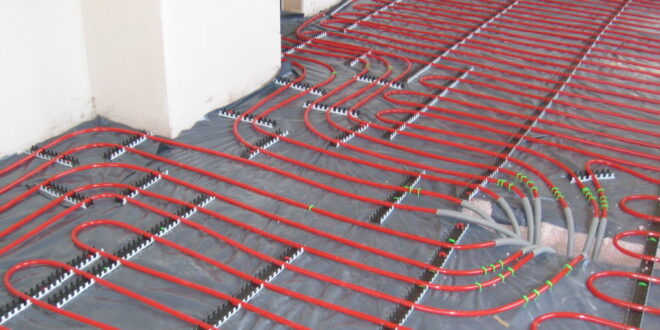Heated floors aren’t just a luxury anymore. When planned systematically, heated floors are worth every penny, both from a comfort and cost point of view. According to the U.S Department of energy, radiant floor heating is a much better option than forced-air heating systems.
The initial underground heater floor cost might be slightly higher than normal, but it saves homeowners a lot in the long run. One of the most important reasons is the amount of comfort offered by underfloor heating systems. But on average, radiant floor heating costs can range from $20,800 (Electric) to $50,000 (Hydronic) for a 2,500 square foot area. Many Canadian homeowners do not have $10,000 lying in their bank accounts for such home improvements.
As a result, your heated floor installation will be a significant investment. Thankfully, you have the option to tap into your home equity to secure a loan through trusted providers. We have stipulated some reasons along with pros and cons to help you make informed decisions on whether heated floors are worth it.
What is radiant floor heat?
To put it simply, radiant floor heating is akin to converting your whole floor into one big heat emitter. This system uses hot water or electrical energy to radiate heat, along a network of electric cables or pipes laid under the floor to heat the surface evenly. Radiant floors are of three types:
- Electric Radiant Floors
- Air-heated Radiant Floors
- Hydronic Radiant Floors
How much do in-floor heating systems cost?
| Type of Radiant Floor | Cost of installation per square foot | Runnin cost per square foot of coverage each month |
| Electric | $8 to $12 | 60 cents |
| Hydronic | $20 | 30 cents |
| Air-heated | $20 | 35 to 70 cents |
Electric radiant floors
In-built floor electric heating systems consist of electric resistant wires evenly embedded into the floor. Pre-built electric mats that can be mounted between the sub-floor and main floor are also available. It is considered the cheapest radiant heating system.
However, due to the high cost of electricity, underground electric heating systems are pricey to run. On the other hand, the upfront costs of electric radiant floors are less than other options.
Hydronic radiant floors
Hydronic radiant floors are a cost-effective and popular underground floor heating system, especially for hot regions. In this system, hot water from the boiler is pumped to a network of pipes snaked into the floor.
Homeowners have the freedom to power the boiler with solar energy, electricity, gas, or furnace. The installation cost of a hydronic radiant system is almost double that of an electric heating system. But, its operating cost is much lower than other options.
Air-heated radiant floors
Air-heated radiant floors also use a network of pipes embedded into the floor to circulate warm air. But, the main drawback of this system is low retention of heat and loss of heat due to leakages. Due to these factors, it is very uncommon in residential setups.
Reasons to install in-ground floor heating systems
Heated floors are more energy efficient
The U.S Department of Energy suggests that radiant floor heating systems are more energy-efficient than traditional HVAC systems. When planned right, it can save up to 50% of the energy bills spent on thermal comfort.
Furthermore, heated floors distribute heat more evenly without leaving any cold spots. Also, it uses convection to transfer heat. Therefore you feel the heat sooner. Such features significantly lower the consumption of electricity.
Heated floors remain warmer for longer
Traditional forced-air heating systems are plagued by several demerits. Since it uses hot air to provide thermal comfort, it heats up fast but does not retain heat for a longer duration. It needs continuous power to keep the indoors warm. Whereas, once the radiant heat warms the floor, it remains heated for longer.
Furthermore, radiant heat transfers the heat to objects placed on the floor, such as furniture and cabinets. In turn, the whole room gets a pleasant warm-up.
Increases resale value
Many homeowners still consider radiant heating floors a luxury. So, if your home has a radiant heating system installed, it increases the property’s resale value.
Radiant heating is more hygienic than forced-air heating systems
Traditional HVAC systems circulate air and might distribute allergens. Whereas, in radiant heating systems, the heat is transferred through convection. Therefore, radiant heating systems are the best for people with allergies.
Radiant heating runs without electricity
Hydronic systems not only run with very little electricity but can use a wide variety of energy sources to operate. Apart from electricity, solar water heaters, standard gas- or oil-fired boilers, or wood-fired boilers can be used to heat the liquid. So, it decreases the dependency on electricity to run heaters.
Cons of heated floors
Although underground heating systems are a great addition to any house, there are a few things to consider before installation.
Costs: The upfront costs, including materials and labour, are high. Sometimes, the need arises to replace the existing floor to embed the heating element. Furthermore, the overall budget may increase depending on the size and type of radiant heating system you choose.
Installation process: The installation process might be lengthy and complex to cause disturbance to the living members of the house.
Operating Costs: Electric radiant heating system running costs are too high.
Maintenance and Repair: As the heating elements are hidden inside the floor, you need professional attention, even for minor repairs. If you’re experiencing issues, consider reaching out to experts specializing in heating repair for efficient solutions.
Are heated floors worth it?
The answer to this question varies according to the area where you live and the type of radiant heating you choose. If you live in an area where electricity costs are too high, installing electric radiant heating might not be worth it. Whereas a hydronic system’s upfront costs are double, the potential energy bill savings are high.
Overall, the benefits outweigh the cons. Moreover, when you plan it right, you can save thousands in utility bill savings in the long run. Lastly, it is a cleaner and energy-efficient method of thermal comfort.
Endnote
Whether you choose to use radiant floor heating as a primary or supplemental heating system, it comes at a cost. However, if you do not have the funds to finance it, you can take out a loan or limit your scope to one or two rooms. Ensure you weigh your financial situation before making any commitments.
 HammBurg Be informed with latest news, reviews, entertainment, lifestyle tips, and much more.
HammBurg Be informed with latest news, reviews, entertainment, lifestyle tips, and much more.




